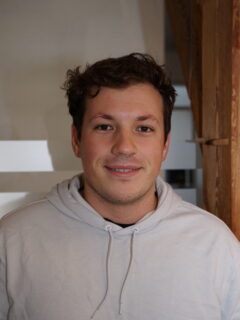Paul Zwießele
Paul Zwießele
Advisors
Daniel Krauß (M. Sc.), Dr. Heike Leutheuser, Luca Abel (M. Sc.), Prof. Dr. Björn Eskofier
Duration
08 / 2023 – 01 / 2024
Abstract
Sleep quality is a direct indicator of a number of physical and physiological diseases [1]. Therefore, reliable sleep monitoring is crucial for the prevention, early detection, monitoring, and treatment of such. A specific example is Parkinson’s disease, of which sleep disturbances are a common symptom [2]. While Parkinson’s is most commonly characterized by motor symptoms, patients are also suffering from non-motor symptoms that range from sleep fragmentation, restless leg syndrome (RLS), to rapid eye movement (REM) behavior disorder (RBD) [2], [3].
The current gold standard for sleep analysis is polysomnography (PSG) [4], [5], which include the measuring of brain activity (EEG), eye movement (EOG), and muscle activation (EMG), as well as the electrocardiography (ECG) and oxygen saturation [4], [6]. Through the analysis of these signals, it becomes possible to evaluate the sleep cycle and related physiological processes [4]. However, there are various limitations associated with PSG recordings. For instance, longitudinal measurements are impractical due to their high cost and obtrusiveness. Additionally, the unfamiliar sleep environment may lead to unrealistic sleep patterns. [5]-[7]. These factors also require patient adjustment (first night effect), so the resulting measurements may not be representative of natural sleep cycles [4]. For that reason, a promising alternative could be a contactless, radar-based sleep tracking system [7]. Using radar sensors, it becomes feasible to detect diverse physiological signals. When coupled with the capacity for longitudinal measurements, it could potentially yield comparable outcomes to PSG, despite the inability to capture identical parameters [7]. During sleep, body movements decrease compared to a wakeful state, Doppler radar systems can capture and quantify the remaining motion [9].
Given this, prolonged sleep monitoring has the potential to provide further insight into the disease’s progression beyond the conventional understanding of its present state [7]. Although radar-based sleep tracking is a promising technology, there still exists limited research on using movement parameters extracted from radar technologies [10]. The goal of this bachelor’s thesis is therefore to implement a sleep analysis pipeline, including preprocessing and feature extraction of movement information from the data of an under-bed 61 GHz radar sensing system, and compare this movement information to the movement extracted from PSG. In particular, the movement of the body corps is compared to the ground truth measurement, which is acquired via actigraphy in the PSG main board. Furthermore, is assessed whether the limb movement can be detected and quantified. Using this movement information extracted from radar, different time-series features are calculated.
As last step of the sleep analysis pipeline, different machine learning and deep learning algorithms (AdaBoost, SVM, MLP, Random Forest, XGBoost, LSTM, TCN) are applied to perform sleep staging based on movement features extracted from radar data (these algorithms are already implemented in the corresponding framework) and to compare the performance of these against the gold standard of sleep measurement, polysomnography.
References
[1] M. K. Pavlova and V. Latreille, “Sleep Disorders,” The American Journal of Medicine, vol. 132, no. 3, pp. 292–299, Mar. 2019, doi: 10.1016/j.amjmed.2018.09.021.
[2] C. L. Comella, “Sleep disorders in Parkinson’s disease: An overview,” Mov Disord., vol. 22, no. S17, pp. S367–S373, 2007, doi: 10.1002/mds.21682.
[3] A. C. Lajoie, A.-L. Lafontaine, and M. Kaminska, “The Spectrum of Sleep Disorders in Parkinson Disease,” Chest, vol. 159, no. 2, pp. 818–827, Feb. 2021, doi: 10.1016/j.chest.2020.09.099.
[4] A. Sadeh, “III. SLEEP ASSESSMENT METHODS: SLEEP ASSESSMENT,” Monographs Society Res Child, vol. 80, no. 1, pp. 33–48, Mar. 2015, doi: 10.1111/mono.12143.
[5] R. de Goederen et al., “Radar-based sleep stage classification in children undergoing polysomnography: a pilot-study,” Sleep Medicine, vol. 82, pp. 1–8, Jun. 2021, doi: 10.1016/j.sleep.2021.03.022.
[6] H. Hong et al., “Microwave Sensing and Sleep: Noncontact Sleep-Monitoring Technology With Microwave Biomedical Radar,” IEEE Microwave Magazine, vol. 20, no. 8, pp. 18–29, Aug. 2019, doi: 10.1109/MMM.2019.2915469.
[7] T. Rahman et al., “DoppleSleep: a contactless unobtrusive sleep sensing system using short-range Doppler radar,” in Proceedings of the 2015 ACM International Joint Conference on Pervasive and Ubiquitous Computing, Osaka Japan: ACM, Sep. 2015, pp. 39–50. doi: 10.1145/2750858.2804280.
[8] M. Fabbri, A. Beracci, M. Martoni, D. Meneo, L. Tonetti, and V. Natale, “Measuring Subjective Sleep Quality: A Review,” IJERPH, vol. 18, no. 3, p. 1082, Jan. 2021, doi: 10.3390/ijerph18031082.
[9] X. Chen and X. Ni, “Noncontact Sleeping Heartrate Monitoring Method Using Continuous-Wave Doppler Radar Based on the Difference Quadratic Sum Demodulation and Search Algorithm,” Sensors, vol. 22, no. 19, p. 7646, Oct. 2022, doi: 10.3390/s22197646.
[10] S. Toften, S. Pallesen, M. Hrozanova, F. Moen, and J. Grønli, “Validation of sleep stage classification using non-contact radar technology and machine learning (Somnofy®),” Sleep Med, vol. 75, pp. 54–61, Nov. 2020, doi: 10.1016/j.sleep.2020.02.022.

